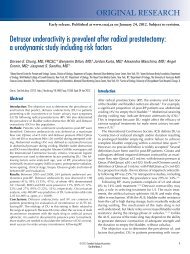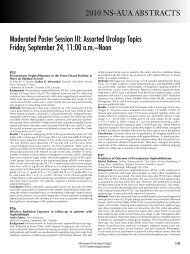Varicocelectomy: microsurgical subinguinal technique - Canadian ...
Varicocelectomy: microsurgical subinguinal technique - Canadian ...
Varicocelectomy: microsurgical subinguinal technique - Canadian ...
Create successful ePaper yourself
Turn your PDF publications into a flip-book with our unique Google optimized e-Paper software.
Point / Counterpoint<br />
278<br />
varicocele recurrence rates or pregnancy rates after<br />
varicocelectomy. 7<br />
There are few studies that compare head to head<br />
the 2 open approaches using <strong>microsurgical</strong> <strong>technique</strong>.<br />
A group of researchers from Italy 8 compared<br />
the intraoperative results of inguinal versus <strong>subinguinal</strong><br />
varicocelectomy using a magnifying loupe<br />
under local anesthesia. The inguinal approach<br />
to the spermatic cord showed a trend toward an<br />
easier preservation of the artery and a reduced incidence<br />
of recurrence, while postoperative pain was<br />
significantly lower in the <strong>subinguinal</strong> group. Orhan<br />
and colleagues 9 retrospectively evaluated 82<br />
<strong>microsurgical</strong> inguinal varicocelectomies and 65<br />
<strong>subinguinal</strong> cases. There was no significant difference<br />
between the 2 groups in operative time,<br />
semen improvement or pregnancy rate, although<br />
the number of veins and arteries was higher in the<br />
<strong>subinguinal</strong> group.<br />
Finally, open <strong>microsurgical</strong> varicocelectomy<br />
has a lower recurrence rate and fewer complications,<br />
compared with laparoscopic varicocelectomy<br />
or retroperitoneal high-open ligation. 10–12<br />
In conclusion, inguinal varicocelectomy is the<br />
original approach and the standard against which<br />
others should be compared. Except in limited situations,<br />
such as previous inguinal surgery or<br />
marked obesity that hinders dissection, <strong>microsurgical</strong><br />
inguinal varicocelectomy should be the<br />
treatment of choice.<br />
From the Division of Urology, Department of Surgery, Murray Koffler Urologic Wellness<br />
Centre, Mount Sinai Hospital, University of Toronto, Toronto, Ont.<br />
Introduction<br />
The treatment of varicocele by percutaneous<br />
embolization of the internal spermatic vein is a<br />
safe and effective minimally invasive procedure.<br />
Its very low morbidity and complication rates, high<br />
long-term success rates and demonstrated cost<br />
effectiveness relative to surgery have led some<br />
authors to argue that percutaneous embolic tech-<br />
CUAJ • September 2007 • Volume 1, Issue 3<br />
This article has been peer reviewed.<br />
Competing interests: None declared.<br />
References<br />
Percutaneous varicocele embolization<br />
J. Robert D. Beecroft, BSc, MD, FRCPC<br />
1. Kass EJ, Chandra RS, Belman AB. Testicular histology in the adolescent with a varicocele.<br />
Pediatrics 1987;79:996-8.<br />
2. Dubin L, Amelar R. <strong>Varicocelectomy</strong>: 986 cases in a 12 year study. Urology 1977;<br />
10:446-9.<br />
3. Su L-M, Goldstein M, Schlegel PN. The effect of varicocelectomy on serum testosterone<br />
levels in infertile men with varicoceles. J Urol 1995;154:1752-5.<br />
4. Goldstein M, Gilbert BR, Dicker AP, et al. Microsurgical inguinal varicocelectomy with delivery<br />
of the testis: an artery and lymphatic sparing <strong>technique</strong>. J Urol 1992;148:1808-11.<br />
5. Hopps CV, Lemer ML, Schlegel PN, et al. Intraoperative varicocele anatomy: a microscopic<br />
study of the inguinal versus <strong>subinguinal</strong> approach. J Urol 2003;170:2366-70.<br />
6. Goldstein M. Surgical management of male infertility and other scrotal disorders. In<br />
Campbell’s Urology, 8th edition. Walsh PC, Retik AB, Vaughan ED, Wein AJ, eds.<br />
Philadelphia: W.B. Saunders; 2002. p 1573-4.<br />
7. Ramasamy R, Schlegel PN. Microsurgical inguinal varicocelectomy with and without<br />
testicular delivery. Urology 2006;68:1323-6.<br />
8. Gontero P, Pretti G, Fontana F, et al. Inguinal versus <strong>subinguinal</strong> varicocele vein ligation<br />
using magnifying loupe under local anesthesia: Which <strong>technique</strong> is preferable in<br />
clinical practice? Urology 2005;66:1075-9.<br />
9. Orhan I, Onur R, Semercioz A, et al. Comparison of two different <strong>microsurgical</strong> methods<br />
in the treatment of varicocele. Arch Androl 2005;51:213-20.<br />
10. Al-Kandari AM, Shabaan H, Ibrahim HM, et al. Comparison of outcomes of different<br />
varicocelectomy <strong>technique</strong>s: open inguinal, laparoscopic, and <strong>subinguinal</strong> microscopic<br />
varicocelectomy: a randomized clinical trial. Urology 2007;69:417-20.<br />
11. Watanabe M, Nagai A, Kusumi N, et al. Minimal invasiveness and effectivity of <strong>subinguinal</strong><br />
microscopic varicocelectomy: a comparative study with retroperitoneal high and<br />
laparoscopic approaches. Int J Urol 2005;12:892-8.<br />
12. Hirsch IH, Abdel-Meguid TA, Gomella LG. Postsurgical outcomes assessment following varicocele<br />
ligation: laparoscopic versus <strong>subinguinal</strong> approach. Urology 1998;51:810-5.<br />
Correspondence: Dr. Kirk C. Lo, Division of Urology, Department of Surgery, Murray<br />
Koffler Urologic Wellness Centre, 60 Murray St., 6th Fl., Toronto ON M5G 1X5;<br />
klo@mtsinai.on.ca<br />
niques should be the primary therapy to treat varicoceles,<br />
or at least a viable and valuable alternative<br />
to surgical options. 1–5<br />
Technique<br />
Percutaneous embolization of varicocele requires<br />
selective catheterization of the internal spermatic<br />
vein(s) followed by its occlusion with either a






